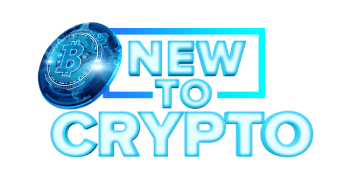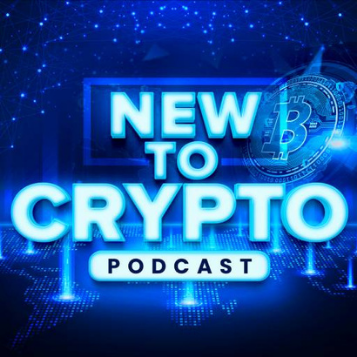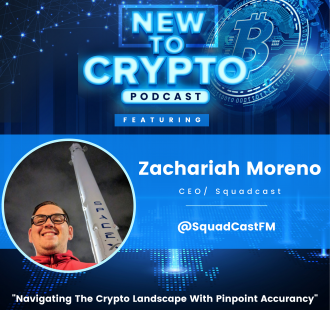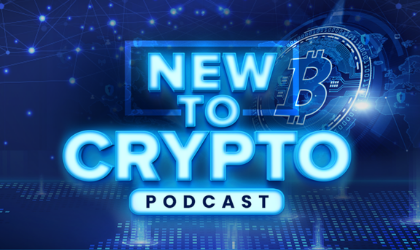What is a NFT with Zachariah Moreno CEO Squadcast
SUMMARY KEYWORDS
crypto, art, artwork, blockchain, sold, people, artists, create, dolby, technology, digital asset, podcast, smart contracts, ethereum, piece, zach, record, bitcoin, monet, painting, cryptocurrency
00:00
Welcome to the New to Crypto Podcast designed to guide you through the crypto landscape with pinpoint accuracy created for the new and intermediate crypto investor. Join your host Crypto Travels Michael as he takes you through the different facets of getting started and succeeding in your crypto journey. New to crypto podcast brings you new episodes daily Monday through Friday with surprise bonus episodes sometimes on the weekend.
00:31
Let me ask you, are you new to crypto, don’t know where to start? Are you more experienced but have questions? Then you’re in the right place. This podcast is designed for You. Coming at you from the Trading Center and the Lifestyle Dezign Studio. Here’s your host Crypto Travels Michael.
00:52
Thank you for tuning in to today’s show. today. I have a very special show for you. And a special guest. This is the very first guest on the New to Crypto Podcast. I’d like to introduce you to a leader in the podcast industry. Located in San Francisco Bay Area, the co-founder and CEO of Squadcast, and the co host of the Crypto Art Podcast, Mr. Zach Moreno. Zach, welcome to the show. It’s my pleasure. Thanks for having me on, Michael. Hey, absolutely. We’re excited about having you on the show today. Tell us a little bit about your company Squadcast and your show Crypto Art. Yeah, so. So with Squadcast, we have the privilege of serving podcasters and professional creators that can’t connect in person to record with others. So we have a cloud studio with a bunch of fancy technology that makes it super easy to like, connect with anyone around the world. Like we’ve helped people record in over 130 countries to produce content together and have these flowing conversations and walk away with professional studio quality audio and video recordings too. To have a great experience for your audience and your listeners. And we’ve been at that about about five years now. So really, really proud of all the creative work that we do that helps others be creative with their podcasts and videos. Fantastic and I recently saw that you guys can now record in Dolby or Dolby Digital. Mm, yeah, we’re really really excited for that collaboration. And of course Dolby is we’re kind of familiar with, like music or cinema. But uh, but podcasting being a medium that’s rooted in audio, it makes a lot of sense and we’re really proud to help Dolby kind of take its first steps into the podcasting ecosystem. We of course focus on the quality of the content we help people record and that’s really where Dolby brings a lot of technology and heritage and magic, quite frankly, to be able to do things like spatial audio and you know, background noise reduction, mastering all that good stuff. Yeah. Wow. Cool. Fantastic. That’s exciting. So just so our listeners know, your customers are, many of them are people who actually have their own podcast show. Yes. Yeah, yeah, exactly. So creators both you know, we love independent creators and podcasters. But all the way up to like ESPN and Microsoft and Google or studios like Marvel, they’re all creating podcasts and, you know, can’t always get together with their collaborators in the same room for like, interviews or voiceover work or audio books, or fictional podcast with bigger cast, like, that’s always a challenge to get everybody in the same studio, especially during a time like the pandemic recently. So that’s really where, where we can help people connect from wherever they’re at in the world and sound great, and the content they record together. Awesome. That’s exciting. And speaking of shows, you have your own, and I know that you’re also an artist, but tell us a little bit about the crypto art podcast. Yeah, when I first kind of started seeing NFT’s and crypto art. It really gave me pause. Because of my background. I am both a computer scientist, but I went to art school and had an amateur art career and crypto artists kind of the blending of technology and art and creativity. I really love it. I very much view it as my personal mission to help to help connect creatives and I feel that creativity is enhanced through collaboration. You know, technology is this connecting force in our world and that coming to life in the art space is something that you know, art sales and art ownership and the creation of art have maybe somewhat been impacted by kind of the technological revolution but but no
05:00
Not necessarily to the degree that crypto art and NFT’s are so and I kind of first stumbled down that rabbit hole, I was like, there has to be a podcast about this. And I was very surprised to find that there were very few, if not any, that were active and was like, Okay, I have background in both of these things. And I’m also very, you know, curious and looking at the crypto space from a computer science perspective. But now from the art perspective, and my co host, Lizzie and I do our best. Like, there’s a lot of the narratives in the crypto space you’re probably familiar with is kind of polarizing. There’s like people who either think it’s gonna change the world and be the bee’s knees and be like the next evolution of humanity. And then there’s other people who are like this is evil and destroying the world. And what we focus on is kind of walking the middle path and trying to keep things balanced between those polarizing perspectives because that’s where I think most average people are. It isn’t somewhere in the middle there. So that’s where we try to take a balanced approach. And that’s what we talk about on the Crypto Art Podcast. Awesome, awesome on our site, we actually have the links for that. And so we’re actually going to talk about a lot of what you just spoke about today, what is an NFT, that’s this episode. And so we’re going to sort of unpack and break down what exactly an NFT is. And so an NFT is actually a non fungible token. It’s a digital asset. And NFT can also be defined as a public verifiable intellectual property, which is authenticated on a blockchain. And so, you know, artwork can be an NFT in an image, a video, even an audio file these days, even a domain name. And as the founder or the CEO of Twitter, he actually made a tweet and NFT, which sold for millions of dollars, even a video game item can be an NFT these days. And so it’s in essence, and NFT is a collectible digital asset. And it holds value as a form of cryptocurrency and also as a form of art and culture. And so Zach, that’s, you know, it’s an exciting space with like, like you mentioned, the collaboration of art and creatives into the tech side, in, you know, to have what we, what we have now is NFTs. Yeah, it’s really exciting stuff. And you may be listening to this and wondering, like, why does art need to be digital? I have, you know, I can go to like Google Images and search for Mona Lisa, and like, look and enjoy that artwork there. How’s this different from that? And technology? Really, I look at it as like, what problem is it solving? You know, what’s the problem that existed for a long time that this is kind of bringing new solutions to. And when you look at artwork, people have been using it as a store of value for a long time, like physical artwork, like paintings on canvas or sculpture, the stuff you think of in museums, right. And those have always been valuable and a store of value, right? Like if I have a Monet, the market will agree upon a price range for that piece. And I can go to Christie’s and auction that off. But really, there’s some issues there that it’s not this necessarily well oiled machine that has just been kind of the state of the art for a long time. So what NFTs bring to that is a new definition of ownership. So you mentioned intellectual property, how do I know who owns this, right? Like, if I go and let’s say you’re the buyer at Christie’s of my Monet, you’re going to get some sort of certificate of authenticity along with that, that says, you know, Michael owns this, this artwork, and that artwork was purchased for this much and therefore that’s its value. And you could go and sell that basically as currency. There’s a market for it. So that’s really where crypto art crypto comes into play . Of course, it’s a digital asset, that’s a store of value, but we tend to think of it more like the dollar or a replacement for gold like in the case of Bitcoin. So those assets are divisible though, like if I give you $1 you could give me four quarters back right.
05:45
Or we could cut a bar of gold in half. So that’s really where the fungible, the non fungible comes from in this term is that an artwork piece of artwork cannot be divided. It’s a one of a kind, and the NFT is, yeah, a record on the blockchain ledger of who owns that and you can buy and sell just like you buy and sell Ethereum or ADA or any of the other coins that you’re into. Mm hmm. Absolutely. It’s interesting that you know, an NFT it’s a piece of art. There’s no exactly
09:59
equal to two another. So both have unique properties. So, and you know, some people might ask if it is an NFT like Bitcoin or Ethereum. Another way to say it is an NFT is a digital token. It’s a type of cryptocurrency, much like Bitcoin or Ethereum. But unlike a standard coin, on a blockchain, an NFT is unique. It can’t be exchanged. And sort of what you were mentioning minutes ago, that it can’t be its own unique properties. And it’s a piece of art for all intents and purposes. Yeah, yeah, just like you wouldn’t cut that Monet in half to say, okay, you own half of it, and I own half of it, right? You it’s an entirety. Ownership has been a kind of a blurry fuzzy thing in technology, because just the nature of computers, any file can be replicated, right? So if we think back to Napster, or something like that, the whole argument was that the root of it was like, well, these are just copies of files, like they still own the original. And that’s kind of what we’re getting at here is like, well, this is a way in technology to say, No, this is the thing, the original thing, and I own it, you can make as many copies as you want, but the value does not carry over to those copies, it only is stored in this one thing and that is proved by the blockchain and you know, the consensus mechanisms that come from Bitcoin or Ethereum, or whatever cryptocurrency you want to make a reference to and a lot of the the NFTs are actually built on top of Ethereum are built on top of other other crypto cryptocurrency platforms. And I’m not sure if you’ve introduced this topic of smart contracts yet to the audience. But smart contracts are one way that Ethereum is different from Bitcoin. But also, creating these additional tokens on top of Ethereum is really what opened up the possibilities of NFT as a separate class of digital assets that anybody can create and participate and buy or sell or create. Absolutely, it’s the extra information that comes with the art or the music or the video in the form of JPEGs, mp3 videos, gifs and more. And yes, I do have a what is a smart contract episode that our listeners can tune into, they can jump over and get plugged in. It’s smart contracts on the blockchain are actually really exciting as well. So Zach, let me ask you, our listeners who may be thinking now they understand what is an NFT? Where can these be bought? You know, where r is there NFT marketplaces are working NFTs are bought and sold.
12:53
Yeah. So NFTs are really gaining popularity. And that’s because companies have emerged to build platforms for buying and selling. So a marketplace. But also there’s the actual process of Okay, I went into Photoshop or I went into like Maya and I went into these creative programs and I created my artwork, I created my digital asset. And if he does, NFTs don’t have any opinions about that. You just want to have a file that is your artwork. And that’s what you’re going to use as a kind of mint, a new NFT. And that’s what’s going to establish kind of the original ownership on the blockchain. And then once that is minted, the artist can then choose to sell it or list it for a price. And you have Yeah, you have platforms that have emerged like Rarible, like OpenSea, and a new one that can’t find anyone who can actually create their own NFT on platforms like Refinable. So let me ask you, our listeners, maybe maybe wondering, okay, so where do I hold the NFT? I go on OpenSea or Refinable. I buy an NFT but where do I hold it? Do I hold it in my wallet like a Metamask wallet? Or where you know, where would they hold their NFT once they either create one in mint one, or once they purchase one? Yeah, and thankfully the technology’s very helpful here and the other one I was trying to remember the name of is called Pixy O’s. And that’s based on a non Ethereum blockchain and has some benefits like much improved environmental impact compared to something like Ethereum. But yeah, you hold it in your wallet. So these platforms connect to Metamask or whatever kind of hot storage wallet you want to use. And then from there, it’s much like any other cryptocurrency where you can transfer it between wallets. You can hold it there and the platform’s do a really
15:00
Great job that you mentioned, like OpenSea and SuperRare and Rarible of still maintaining that you created this. And that’s one of the beautiful things here, like it doesn’t exist, like I’ve sold paintings and art shows and stuff. And I have no idea who owns those. Now the artist creates it, they sell it, you’re the first one to sell it, if you’re lucky. But who knows where that person took it and sold it. And because blockchain is a ledger, this is actually one of the superpowers that blockchain technology brings to the art world is now we have a ledger from inception, to current of all the different owners of it, and the meta, the metadata of what it sold for what it was bought and sold for and how it changed hands over time. And that’s not something that exists for like, you know, who, who owns that Monet, before I sold it to you at Christie’s for this price, you know, and there’s another superpower that I love to talk about that has never existed in practical terms for artists. That’s this idea of royalties. So when I when I go and mint on, let’s say, super rare, and I take my artwork, I did it in like procreate on my iPad, and I have my picture, and I’m gonna go to variable and I meant it, I can choose to say when I in the minting process, like I want as the as the creator, I want to retain 10% or some percentage of the future transaction amounts. So if you go and then like you choose to sell my Monet that I sold, you Monet could get a cut of that, you can attach a commission to the file. So every time your artwork is bought and sold, it’s like a royalty or payment on the resale is automatically sent back to you. Right. And that automation is where the smart contracts take this and make it so that humans don’t have to go and like I don’t have to go and collect on you and say, Hey, you owe me this 5% 10% it just happens as a side effect of the transaction. And this is beautiful because there’s of course the trope of the starving artists. And I believe that this is a real force for good as a solution to help artists continue to get paid for their work as it gains value, right? If you think about artwork, the artist is always the first one to sell it. That’s probably the cheapest that piece will ever be; it’s only likely to appreciate in value over time. And the artist in the physical world doesn’t benefit from those future resale prices increasing. So that’s really where the this royalties mechanism i think is like a real benefit to artists like I’ve talked to a bunch of people who are like, but I don’t get it like what what how is this any different from me just like going on Instagram and saying hey, do you want to buy this piece? I’ll ship it to you and you get this money cool. This is a concrete answer to that one is like the ledger you get to see who owns it where it is and all that cool stuff. But that’s not really like money in the bank. Right? So this is the royalties really is a game changer I believe for the starving artists. Hopefully, hopefully we have rich artists in the future because of this technology. Absolutely, absolutely. There’s also another way that NFTs are changing this space. They’re also available as in game purchases across different video games right now. So these assets can be bought and sold by players. And basically they can include playable assets like things like swords and skins and avatars. And I know super farm is doing great things with the NFTs in this area regarding games, musicians can also sell rights and originals of their work. And so there’s you know, there’s a lot of exciting things going on. And just so some of our listeners, you know that maybe they’ve never heard of an NFT and we want to kind of unpack and let you know that some of these NFTs are selling literally for millions of dollars for one NFT. Like Jack Dorsey, CEO of Twitter. The first ever sold tweet on the blockchain sold for $2.9 million. And there’s an artist by the name of Beeple. His Everyday first 5000 days NFT sold for a record breaking $69 million. That’s US dollars. So there’s a lot of celebrities that are now embracing and creating their own NFTs. Everyone from Paris Hilton to Snoop Dogg, everyone in between, such as Lindsay Lohan, Tony Hawk, Eminem, you know, Kate Moss, Shawn Mendes, and many more. I think Zach, it’s safe to say that NFTs are definitely here to stay. Yeah, and they’re definitely having a bit of a cultural moment right now. And that’s what’s really awesome to see. When I first kind of got exposed to some of the metrics that you just shared, like the amazing success was like, whoa, hold on a second. That’s crazy. That makes people think this is a quote among the top three most valuable living artists. So this isn’t just a financial
20:00
That’s like the crypto niche, right? That’s a record amongst all living artists. And that’s incredible. So that really gave me pause when I first saw this NFT kind of wave starting to crest and his thing that I was very skeptical to be straight up when I when I first started looking at super rare and the artwork listed so if you’re curious to see what is an NFT, go to SuperRare go to OpenSea just like Google those, and you’ll see all of the artwork there. So from my background, right, I went to art school. I am, you know, classically trained in graphic design and have worked with a lot of other artists and had my own kind of amateur art career. So what I was trying to distinguish, when I first looked at this space was like, Is this just like, nerd selling finger painting? And people are like, Oh, this is collectible, and therefore it’s worth money, or completely separate from that? Is it actually quality art? Like if you were to just remove all of the other stuff, right? The NFT stuff, the cultural hype moment that’s going on, you could argue it’s in a bubble. Like, if you just set all that aside, and I was just to like, walk into an art gallery and look at this on a wall? Is it actually good quality art? Is this like a value? Did people put time and effort into it thought provoking? Like all the different ways you could try to, of course, a lot of this is subjective, but trying to look at it objectively is the quality of the product actually, very high. And that’s what I was very surprised with was the quality is there like these, these are professional artists. And this is very time consuming, thought provoking crafted pieces of art. And that’s really where I was like, okay, that this is awesome, you know, like, this is really awesome. And then when I found out the piece about the royalties was like, wow, this is actually going to be a force for good here. So it’s, it’s really amazing, because you know Beeple, whose people just to be straight up, but he’s, you know, minor success before this. But you know, looking at that first 5000 days piece, selling for close to 70 million is awesome. And you look at the artwork itself. And, you know, you tell me, you know, listeners, let us know, do you think it’s good quality art? Does it make you consider, you know, your place in the universe and you know, life and all of those things that good art makes us kind of think twice about? Absolutely. Well, there you have it directly from Zach Moreno in the Bay Area, breaking down and unpacking for you today about what is an NFT and all the exciting facets of depth of what’s going on in this space. So we thank you for tuning in today. And Zach, we’re gonna have to have you come back out for a future episode. I’d love that. And thank you for this opportunity to talk about one of my favorite subjects like I love the future, but to see art having, you know, kind of a renaissance so to speak in the digital digital times is really beautiful to see. And yeah, I encourage people to go deeper into some of what we share today. Absolutely. Thank you very much, jack, and we look forward to having you on again. Thanks for tuning in to New to Crypto Podcast. If you liked the episode, be sure to follow and subscribe. You can listen to every episode on all major platforms and have an interest in being on the show or one advertising reach out at new to crypto.io. Head over to our site new to crypto.io to access the resources mentioned in each episode. Until next time, remember to navigate the crypto landscape with pinpoint accuracy.
![What is 1inch Network [DeFi and DEX]](https://newtocrypto.io/wp-content/uploads/2021/12/What-is-1inch-Network-DeFi-and-DEX-300x300.jpg)














